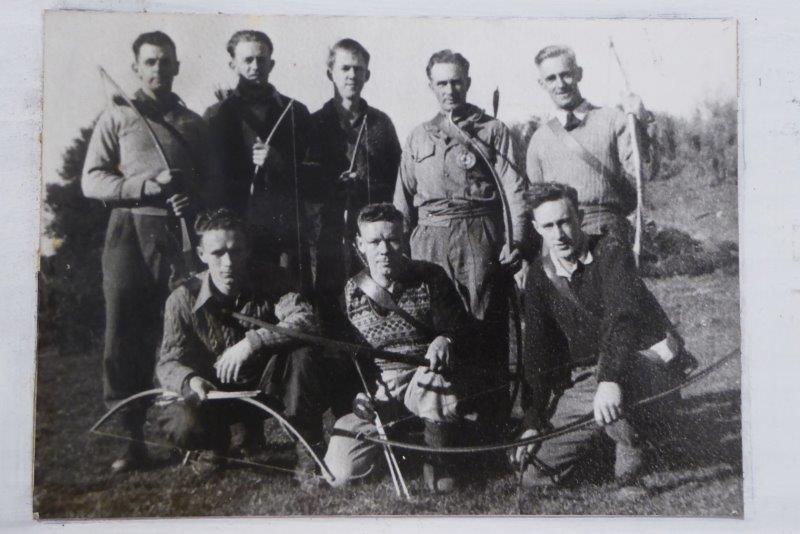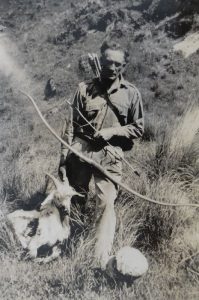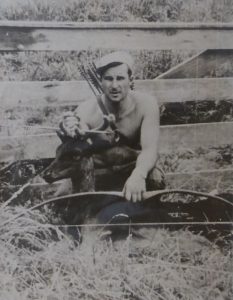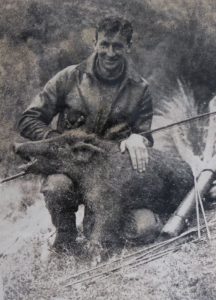The Formation of the NZ Bowhunters Society
Prepared by Dave Gousmett
The New Zealand Bowhunters Society was incorporated on the 24th June 1955, but that was by no means the start of organised bowhunting in New Zealand. I am indebted to Ray Lane for his research into the early years of archery in this country and I have used much of his material to prepare this history.
Archery as a sport was established as early as 1861 when there was an archery club in existence in Auckland. The Thorndon Archery Club from Wellington was also active at about this time and shot competitively with the Auckland club from 1873. In the South Island an archery club was formed in Christchurch around September 1869. No doubt some of the club members also took their bows hunting but no records are available as to what game was hunted.
It is generally believed that the Dunedin Archery Club was the first of the modern archery clubs to be founded in 1939. Archery in Gisborne was established in 1942 and the Auckland Archery Club was formed in 1944. Two of the Auckland members, Wattie Harriman and Claude Hyauiason, were also keen bowhunters and in 1945 they formed a ‘hunting section’ of the club.
They invited six others to join them as a group. They were Sid Mitchener, Les and Norm Murgatroyd, Jack and Archie Simpson and Gordon Stacey, all of whom by that time had the equipment for hunting or were capable of making it. They had a very ethical set of rules which they adhered to strictly and this was probably one of the reasons why shooting access was not hard to find.

Standing: Claude Hyauiason, Wattie Harriman, Gordon Stacey, Les Murgatroyd, Sid Mitchener
Kneeling: Jack Simpson, Archie Simpson, Norman Murgatroyd
Both Wattie and Claude had authentic English longbows but most members had to make their own hunting bows which task was not made any easier by the lack of available material. One option that was tried was to cut and shape a hickory pick handle, although this was not very satisfactory. Osage timber was also used when a suitable tree was found growing in Auckland. Lemonwood was being used extensively in the United States at this time and 100 staves were imported which enabled members to further experiment and improve their designs. These early bows were all one piece or ‘self’ bows but they were soon to be replaced by laminated wooden bows which provided more scope for improvement in bow design and arrow cast.

Les Murgatroyd and Wattie Harriman were two bowyers who used this technique. Oregon was the preferred timber for arrows with the wing feathers from wild turkeys used for flights while the broadheads were made from old saw blades.
As there was no local game award system in New Zealand many bowhunters joined the National Field Archery Association of America which catered for field archery and bowhunting. They had a game award system for both big and small game – the Art Young awards – for which NZ hunters were eligible to compete. Auckland archers also set up their own field course on Mount Smart and this interest in hunting and field shooting was reflected in other parts of the country with Oamaru, Christchurch, Wellington and Masterton clubs setting up their own hunting sections.
Several types of big game had fallen to bowhunters in both islands. Wild pigs had been taken in the Orongorongos in 1940 by Wellington archers G. Coburn and David Robie, and Ian McVinnie from Oamaru shot a 150 lb pig in 1941 at Hampden between Oamaru and Dunedin. The first recorded deer taken with a bow in this country was a fallow deer shot by Lofty Rutherford from Ranfurly in the Blue Mountains in 1942 and he also shot a big wallaby at Waimate in 1946. Bowfishing was also represented and a seven foot shark was taken with a bow during a fishing trip near D’Urville Island in 1947 by T.C. Svenson. As well as big game a considerable number of goats and rabbits were taken and it was reported that Hugh Bell from Christchurch shot nine rabbits in an afternoon.

With the increasing popularity of bowhunting it was decided to set up a national organisation and a meeting was called by the editor of the NZ Archer, John Thuell. This resulted in the formation of the NZ Bow Hunters Club in August 1951. The membership rules and game award system was based on that of the NFAA of America. The club proved a success drawing members from all over the country with many different species of game claimed, including deer. In 1952 Les Murgatroyd, Doug Edkins and Don Anstis all shot fallow deer on the South Kaipara Peninsula while Archie and Jack Simpson were both successful on red deer from the Taupo district.
Bowhunting equipment was becoming more readily available from local manufacturers and a lot of imported equipment was also for sale in sports shops. Until now the majority of bows used for hunting had been longbows but two developments saw an increase in the popularity of recurve bows. The advent of plastics coupled with the improvement in glues had a great impact on the performance of the bows. By laminating a thin strip on either or both sides of the bow, the bowyer finished up with a limb that curved away at the top. The plastics were so strong and durable compared to wood that it was now possible to make this recurve type of bow without fear of it breaking under use. The tubular steel recurve bow had also hit the market and this was to prove very popular, not only for its speed and accuracy but because it was almost unbreakable in the field.
This increased availability of reliable bowhunting equipment attracted many new hunters to the sport and it was decided to set up a more formal organisation for the management of bowhunting in New Zealand. A special meeting of the NZ Bowhunters Club was held at the Auckland Archery clubhouse on the 16th February 1955. As a result of this meeting the New Zealand Bowhunters Society was constituted on the 24th June 1955 and this superseded the NZBHC. The objects of the Society were broadly the promotion and encouragement of the sport of bowhunting in New Zealand. The first elected officers were Herb James as president with Graham Cutler as secretary. The committee consisted of Sid Mitchener, Les Murgatroyd, Jim Hinchco and Doug Edkins. A Constitution and Code of Ethics were adopted. The Code of Ethics in particular was very similar to what we have today. The annual subscription fee was 10/- (one dollar).

The game award system consisted of two awards, one for big game and one for small game. Big game consisted of: Deer (all varieties), Moose, Elk, Wild Pig (min. weight 40 lbs, without dogs), Wallaby, Tahr, Chamois, Shark (over 5 ft) and Swordfish. The small game award system listed various point values for the different species with a total of 100 pts required to obtain the award.
In 1957 a special meeting of the NZ Bowhunters Society was held at Levin during the National Archery Championships where Sid Mitchener suggested that the operations of the society might be further expanded if the headquarters were moved from Auckland to a more central location. Members of clubs in the New Plymouth area had signified their willingness to undertake the responsibilities of office and Trevor Prestney was elected president with Brian Knauf as secretary. Among the changes made was an overhaul of the game award system with the number of awards increasing to five big game awards and five small game awards. For big game each award had to be won on a different species of big game while for small game the number of points for each award were 20, 30, 50, 70 and 100 for each successive award with no more than 20 pts in any one species for each award. The colours of the award patches (white, black, blue, red and gold) represent the sequence of colours on an archery target.
The first NZ Bowhunters Society annual Tournament was held at New Plymouth in 1958 on Queen’s Birthday weekend. There were 43 competitors from all parts of the North Island. The competition was aggregated over a 28 target broadhead round, a 56 target bowhunters round and a 28 target field round. The first Tournament champion was Jim Hinchco from Auckland who later became an accomplished bowyer and many game animals in the sixties and seventies were to fall to Hinchco recurve bows.
Other images relating to this article and period can be found here.
